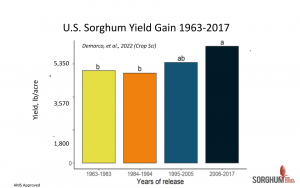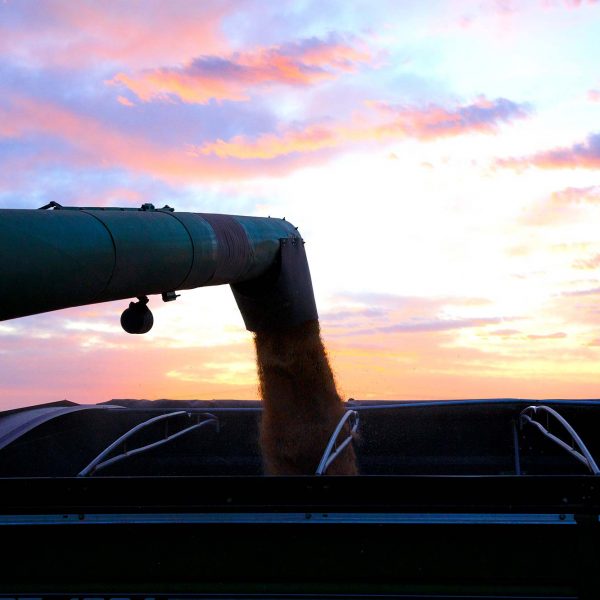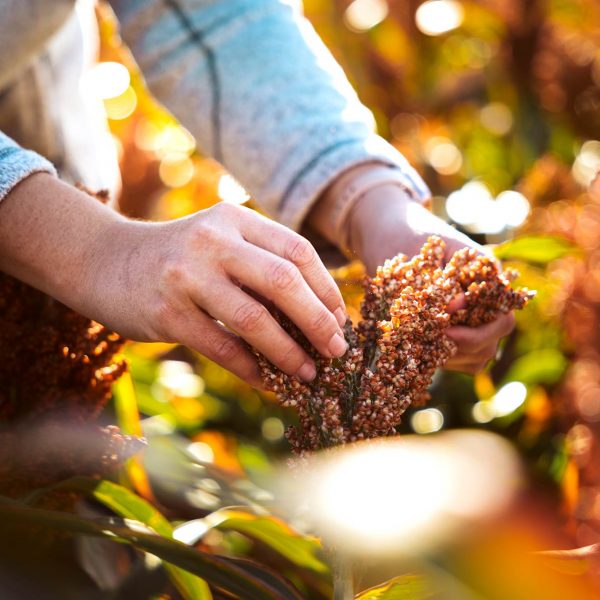Better Sorghum Hybrids for 2023
Brent Bean, Director of Agronomy, USCP
HP/MAFG February 2023
With dry soil profiles throughout most of the sorghum belt, coupled with high input costs, it is anticipated that planted sorghum acres will be up in 2023. One of the most important decisions growers can make is which hybrid to plant. Historically, the release of new sorghum hybrids has been slower than some of the other crops, however, in the last five years many new hybrids have been released by seed companies providing growers with new options to consider.
The yield gain of grain sorghum from 1963 to 2017 was recently studied by scientists at Corteva™ Agriscience and Kansas State University with the findings being published in Crop Science Journal. Yield gain of Pioneer® commercial hybrids increased 24 lbs/acre per year over that time period. What was particularly interesting was yield gain has accelerated in recent years (see bar graph), with a significant yield increase for hybrids released from 2006 to 2017.

In the coming years, growers should expect the rate of yield gain to increase as new breeding techniques are adopted. The use of double haploid and other technologies should reduce the time to develop a hybrid by at least four years. In addition, and maybe even more importantly, the gain in knowledge of the location of important genes on chromosomes, coupled with powerful computer programs, will make breeders much more efficient at selecting superior parent lines for crossing to make better hybrids.
Before a new hybrid is released by a seed company it is rigorously tested under multiple environments. Companies will not bring a hybrid to the market unless it has some significant advantage over other hybrids that they sell.
Higher yield is always the goal and is accomplished by the hybrid simply having a higher yield potential under optimum conditions or having better defensive traits that equip the hybrid to better withstand abiotic (nonliving) and biotic (living) stress.
Abiotic stress is typically caused by drought and high temperatures. Since sorghum tends to be grown in dry environments, sorghum breeders spend a large portion of their efforts in developing hybrids that can withstand periods of drought and still maintain yield potential. Often overlooked by growers is the importance of heat stress. Much of the U.S. has experienced elevated temperatures the last few years, and this is not expected to change any time soon. More effort is going into breeding for heat stress than in the past.
Biotic stress is usually from insects or diseases. Sorghum companies have placed considerable effort in identifying hybrids and parent lines with sorghum aphid (previously known as the sugarcane aphid) tolerance. Most new hybrids now have tolerance to sorghum aphid. For those regions where diseases are an issue, better anthracnose resistance has been incorporated in some of the new hybrids. The newest advance in sorghum hybrids has been the introduction of herbicide tolerance. These new hybrids allow for grower access to specific herbicides previously unusable in sorghum. There are three effective, grass controlling herbicide technologies now available:
- Double Team™ hybrids from S&W Seed, tolerant to FirstAct™ herbicide, sold by ADAMA
- Igrowth® hybrids from Advanta Seeds, tolerant to ImiFlex™ herbicide, sold by UPL
- Inzen™ hybrids from Pioneer, tolerant to Zest™ herbicide, sold by Corteva
Each of these technologies was developed with conventional breeding techniques and are non-GMO.
Contact your seed company to discuss these new herbicide tolerant hybrids and other recently released hybrids that have superior yields with better drought, heat, insect and disease tolerance.




